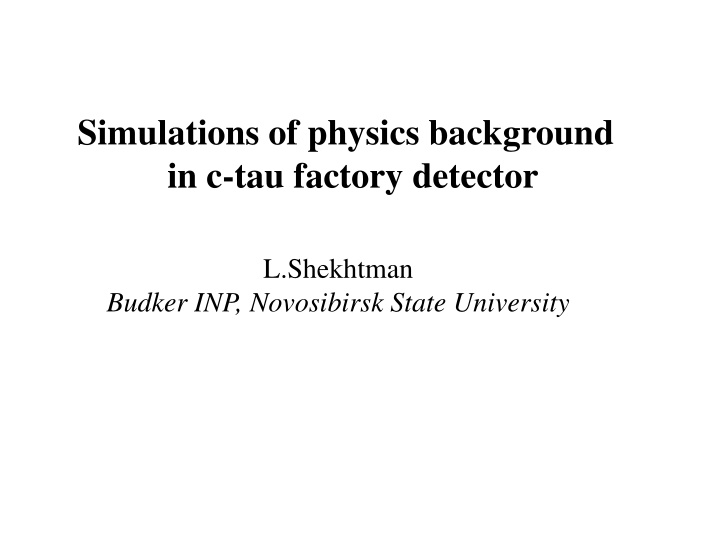
Simulations of Physics Background at C-Tau Factory Detector
Delve into the detailed simulations of physics background at the C-Tau factory detector conducted by L. Shekhtman from Budker INP, Novosibirsk State University. Explore main physical background sources, generated events, geometry descriptions, magnetic fields, and various particle fluxes within the detector. The goal is to estimate background particle fluxes in the Inner Tracker region to determine occupancy values for different Inner Tracker options.
Download Presentation

Please find below an Image/Link to download the presentation.
The content on the website is provided AS IS for your information and personal use only. It may not be sold, licensed, or shared on other websites without obtaining consent from the author. If you encounter any issues during the download, it is possible that the publisher has removed the file from their server.
You are allowed to download the files provided on this website for personal or commercial use, subject to the condition that they are used lawfully. All files are the property of their respective owners.
The content on the website is provided AS IS for your information and personal use only. It may not be sold, licensed, or shared on other websites without obtaining consent from the author.
E N D
Presentation Transcript
Simulations of physics background in c-tau factory detector L.Shekhtman Budker INP, Novosibirsk State University
Main physical background sources: 1. Two-photon processes e+e- e+e-e+e- 6 mb (at 3.5 GeV per beam) 2. Radiative Bha-Bha e+e- e+e- (n ) ( >5mrad, E >3MeV) 1.7 mb (at 3.5 GeV per beam) With 1035 cm-2s-1 - ~8x108background events per second If frequency of bunch crossings is 2x108- ~4 events per crossing, ~8 background particles with >5mrad
Generated: 1 mln. events with two-photon e+e- production, generator diag36, cross-section ~6 mb (F.Ignatov) 105 e+e-n generator BHWIDE (LEP/SLC), c 1.7 mb ( >5mrad, E >3MeV) (help of V.Tayurskij) Simulation of background particles fluxes is performed with FLUKA package (http://www.fluka.org) Main goal is to estimate background particle fluxes at the region of Inner Tracker, to get occupancy values for different options of IT
CTD geometry in FLUKA R, cm Concrete Iron Aluminum CsI Aerogel He+40%C3H8 Air Ar VP Z, cm
Magnetic field B, T R, cm 100 100 0 100 200 Z, cm R, cm 100 260 0 Z, cm
Electrons & positrons (TPC) 1/cm2s R, cm Z, cm
Electrons & positrons 1/cm2s Y, cm X, cm
Photons 1/cm2s R, cm Z, cm
1-MeV neutron equivalent flux for Si 1/cm2s R, cm Z, cm
Absorbed dose G/y R, cm Z, cm
v09 v10 R, cm R, cm Comparison with v08
v026 Thickness of end-cap TPC wall affects the flux v026 v06 R, cm
Options of Inner Tracker option Channel size Time of the measurement 1x1 mm2 TPC 100 ns 300x0.2 mm2 Si-strip detector 10 ns 300x0.4 mm2 CGEM detector 100 ns ~600x10 mm2 Straw tubes 100 ns ~600x5 mm2 Compact drift chamber 100 ns
TPC, rates e+e- 105- 103particles/cm2
TPC, occupancy (fraction of time when system is busy) Time slice 100 ns factor 10-7 Readout pads 1x1 mm2 factor 0.01 Occupancy = rate x 10-9 10-4 10-6 Ion space charge Rate 105 3x1011ions in region 1x1x30cm3 (10% ion backflow) Field of space charge Esc~ Q/ 0 = 50 V/cm External field 500 V/cm
Straw tubes, rate Rates 105 (!) 103particles/cm2s
Straw tubes, occupancy Length 60 cm, factor 60 Drift time 100 ns factor 10-7 Occupancy = rate x 6x10-6 1 0.01 Charge flow 105tracks per cm per s -> 107primary electrons Gas ampl. 105 > 1012 e = 1.6x10-7C/sxcm = 1.6 C/cm per year
Si-strip detectors Rate 105 103cm-2s-1 Channel size 0.02x30 cm2 Time 10 ns Occupancy = Rate x 0.6x10-8 10-3- 10-5
CGEM detector Rate 105 103cm-2s-1 Channel size 0.04x30 cm2 Time 100 ns Occupancy = Rate x 1.2x10-7 10-2- 10-4
Conclusions Charge particles rate in the region of Inner Tracker 105 103cm-2s-1 Occupancies are too high for straw tube option (and for compact drift chamber) Occupancies for other options of IT are acceptable 1 MeV n-equivalent flux for Si is below 1011n/cm2y Absorbed dose is below 100 Gy/y (rad-tolerant electronics needed)
